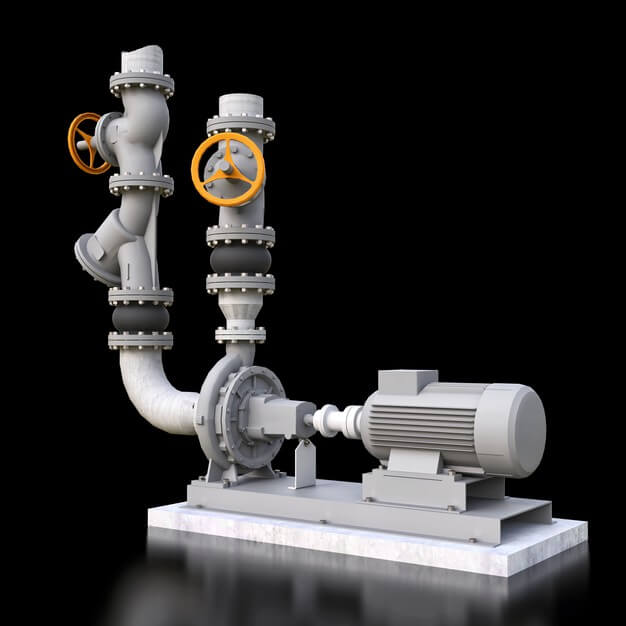What Are the Different Types of Water Pumps?
Water pumps have been around for a long time. H.A Wirtz developed the first one in 1736. A stream wheel powered it to raise water for use at a dye house. Since then, water pumps have continued to evolve and are now incredibly sophisticated pieces of equipment with many applications. Industrial uses are some of the most common for water pumps. For example, industrial pump services are used to remove water at construction sites, displace water after heavy rainfall and irrigate crops. For each situation, there is a type of water pump like a vertical turbine pump that is best suited for the job.
There are two major types of water pumps; centrifugal pumps and positive displacement pumps, each with its subcategories. By understanding the different kinds of water pumps, and when they are used, project managers can make better decisions regarding which one to use.
Centrifugal Pumps

The first major type of pump is a centrifugal pump. According to Intro to Pumps, a centrifugal pump is “a machine that uses rotation to impart velocity to a liquid and then converts that velocity into a flow.” A centrifugal pump is made up of a pump shaft, a sealing mechanism, and other components to help the pump handle operation stress. Centrifugal pumps must remain filled with fluid at all times to function properly.
Inside the pump is also an impeller, which rotates to provide velocity to the liquid being pumped. This impeller spins rapidly, run by a motor, which forces the liquid in a specified direction. Centrifugal pumps come in several different kinds:
Vertical Turbine Pumps
A vertical turbine pump, also known as a vertical pump or lineshaft pump, is a centrifugal pump that transports water from deep underground. A common type of vertical turbine pump is a submersible pump, which is situated entirely underwater. With a submersible pump, the motor is located at the bottom of the system. Submersible vertical turbine pumps are often used when the liquid is far underground, such as in sewage services.
One advantage of using a submersible vertical turbine pump is the noise level. Due to being far below ground and underwater, this type of pump produces much less noise. In addition, submerged pumps do not need to be primed since they are already underwater.
Other vertical turbine pumps have their motors mounted at the top of the system, with impellers connected through a long shaft. In this configuration, the motor remains dry and is easier to maintain. Our blog post on how vertical pumps work provides a more in-depth look at this system.
End-Suction Pumps
One of the more common types of centrifugal pumps is an end-suction pump. This type of pump consists of a single impeller along with a horizontal shaft. These pumps can be altered easily to allow them to pump different types of liquids or solid materials.
Multistage Pumps
The last type of centrifugal pump is called a multistage pump. These pumps have multiple impellers, which provides the pump with additional force. This higher pressure force is required in many instances, such as pipelines.
Positive Displacement Pumps

A positive displacement pump is one where a certain amount of liquid is brought inside the pump’s cavity, and then that same amount is discharged. Depending on the type of pump, this displacement occurs either via a piston, diaphragm, or plunger. To bring the fluid in, a form of suction is used on the inlet side as the cavity expands, then discharged as the cavity decreases. Like centrifugal pumps, there are different types of positive displacement pumps, including:
Rotary Pumps
Rotary pumps run off the rotation of a rotary, which is anything that revolves around a center axis. As the rotary turns, it displaces fluid from the reservoir into the discharging pipe. Two common examples of a rotary pump include a screw pump and a sliding vane.
Reciprocating Pumps
A reciprocating pump uses a piece that moves forward and backward to transfer the fluid from the reservoir. Common examples of a reciprocating part include a plunger or a piston. As the liquid is being brought into the reservoir via suction, inlet valves open up while the outlet valves remain closed. To discharge the fluid, the inlet valves close, and the outlet valves open.
Linear Pumps
Linear pumps get their name from the fact that they operate in a straight line. A classic example of a linear pump is called a chain pump. In a chain pump, circular discs are attached to a long chain. As the chain moves up the tube, the discs carry the trapped water, where it is discharged at the top. Modern linear pumps are more sophisticated but operate on the same basic theory.
Understanding the Many Kinds of Water Pumps
When a fluid pump is required, it’s important to know which kind is best suited for the task. Choosing between a vertical turbine pump or a rotary pump will greatly impact the outcome of the task. Luckily, by working with a trusted provider of industrial pump services, such as Zone Industries, the right type of pump isn’t hard to find.
What Are the Different Types of Water Pumps? | Zone Industries
